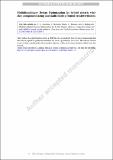| dc.contributor.author | Anselma, P. G | |
| dc.contributor.author | Niutta, C. B | |
| dc.contributor.author | Mainini, L. | |
| dc.contributor.author | Belingardi, G. | |
| dc.date.accessioned | 2021-09-20T17:30:58Z | |
| dc.date.available | 2021-09-20T17:30:58Z | |
| dc.date.issued | 2020-05-06 | |
| dc.identifier.uri | https://hdl.handle.net/1721.1/131926 | |
| dc.description.abstract | Abstract
The electrification of road vehicle powertrains has recently gained growing interest worldwide as an effective solution to comply tightening regulations on CO2 emissions. In hybrid electric vehicles (HEVs), multiple power components, such as internal combustion engine, electric motor/generators, and battery system, are included in the powertrain to improve vehicle performances, thus involving an increase of the powertrain envelope and of the overall vehicle mass. Larger vehicle mass affects the design of the structural framework, which expands its envelope to meet safety requirements. The expansions of both powertrain systems and structural framework are indeed constrained by the limited vehicle widthtrack, which demands for tradeoff studies at early vehicle design phases to achieve a feasible solution while optimizing performances related to different design disciplines. These particularly include proper sizing of power components to achieve optimal fuel economy capabilities and accurate design of structural components to satisfy crashworthiness criteria while minimizing the associated structural mass. In this framework, the achievement of a globally optimal solution requires a cooperative development process that addresses the design problem accounting for all these disciplinary contributions in an integrated manner. This paper proposes a multidisciplinary design optimization (MDO) framework for the preliminary design of a power-split HEV powertrain accounting for crashworthiness requirements. A multidisciplinary feasible optimization architecture is particularly illustrated that includes a sequential scheme to evaluate the disciplines and a direct search method as the global system optimizer. Different sizes are swept for the internal combustion engine, the electric motors, and the planetary gear ratios. A multi-fidelity approach is considered for the crashworthiness analysis, to assess the feasibility of powertrain configurations. Results show that, including crashworthiness analysis in the MDO formulation of the design problem, the identified optimal design differs from the outcome of a powertrain-only based optimization process. Particularly, benefits in terms of global solution feasibility and associated computational cost are achieved. The presented methodology allows to efficiently integrate powertrain analyses and crashworthiness constraints and it is suited for the early design of HEVs. | en_US |
| dc.publisher | Springer Berlin Heidelberg | en_US |
| dc.relation.isversionof | https://doi.org/10.1007/s00158-020-02603-6 | en_US |
| dc.rights | Article is made available in accordance with the publisher's policy and may be subject to US copyright law. Please refer to the publisher's site for terms of use. | en_US |
| dc.source | Springer Berlin Heidelberg | en_US |
| dc.title | Multidisciplinary design optimization for hybrid electric vehicles: component sizing and multi-fidelity frontal crashworthiness | en_US |
| dc.type | Article | en_US |
| dc.contributor.department | Massachusetts Institute of Technology. Department of Aeronautics and Astronautics | |
| dc.eprint.version | Author's final manuscript | en_US |
| dc.type.uri | http://purl.org/eprint/type/JournalArticle | en_US |
| eprint.status | http://purl.org/eprint/status/PeerReviewed | en_US |
| dc.date.updated | 2020-09-30T03:48:10Z | |
| dc.language.rfc3066 | en | |
| dc.rights.holder | Springer-Verlag GmbH Germany, part of Springer Nature | |
| dspace.embargo.terms | Y | |
| dspace.date.submission | 2020-09-30T03:48:09Z | |
| mit.license | PUBLISHER_POLICY | |
| mit.metadata.status | Authority Work and Publication Information Needed | |
